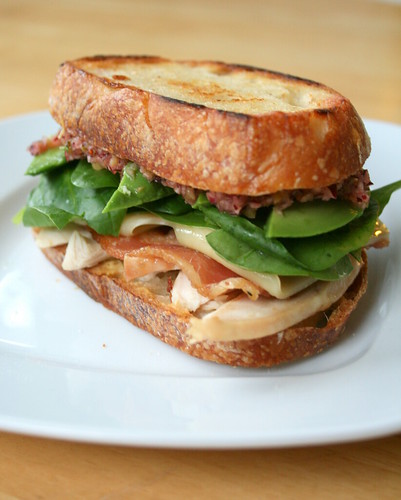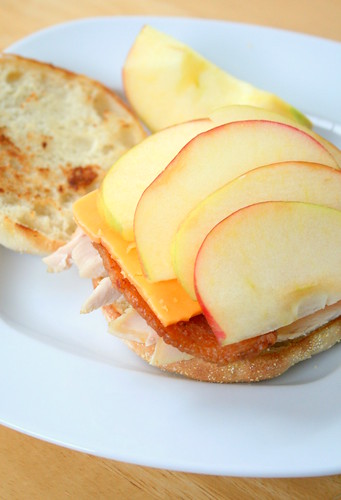
It’s been a while since I baked a cake, in fact, it’s been a while since I last baked anything. No wonder I’ve been so grumpy and irritable lately. Thanks goodness for this long weekend and the Daring Bakers for bringing me out of this baking slump. And what better way to do that than with lots of dangerous molten sugar. Good times indeed.

Our hosts this month are Dolores, Alex, and Jenny and the recipe they've selected comes from pastry chef extraordinaire Shuna Fish Lydon and it’s her signature caramel cake with caramelized butter frosting. Sugar coma here I come.
By the time I started my cake, many if not most DBs had already finished and posted their take on the caramel cake, which is how I stumbled on Hannah’s beautiful caramel cake roulade. I hate frosting cakes (I'm too OCD in trying to make the frosting perfect) so I thought this was the perfect stress-free way putting together the cake and *cough* shamelessly copied Hannah.
I think my caramel syrup ended up being a little too dark (this is what happens when you take your eye off caramel for one second) but *shrug* its okay, it’ll just have more developed flavors and um, smoky undertones right? Instead of adding water to the caramelized sugar, I added orange juice, which gave it a really unique taste. I also used eggnog instead of milk in the cake batter and 1/4 tsp of ground nutmeg. The batter looked a little on the thick side so I added more eggnog, which was not the best move because it screwed with the ratios and made the cake kinda gummy. The eggnog flavor also overpowered the caramel notes in the cake. Next time, if I wanted an eggnog cake, I’ll just skip the caramel syrup and if I want a caramel cake then I won’t add any competing flavors. The frosting was mindblowingly delicious, I would have eaten it by the spoonful but I kept telling myself I would just be eating butter and sugar... a little gross when you think about it. Even though the cake turned out gummy and it isn't the prettiest caramel cake on the block, it was still pretty darn tasty. However, I did find the cake to be on the sweet side even after I trimmed down the sugar. This recipe is definitely a keeper and is something I’ll tinker with some more.
I was lazy and skipped making the spun sugar decorations and caramel candies. Instead I just brushed the cake with some leftover caramel syrup.
Caramel Cake with Caramelized Butter Frosting
By Shuna Fish Lydon - http://blogs.kqed.org/bayareabites/2006/12/24/caramel-cake-the-recipe/
Caramel Cake
10 Tbsp unsalted butter at room temperature
1 1/4 C granulated sugar
1/2 tsp kosher salt
1/3 C Caramel Syrup (see recipe below)
2 eggs, at room temperature
splash vanilla extract
2 C all-purpose flour
1/2 tsp baking powder
1 C milk, at room temperature (in my case eggnog and 1/4 tsp nutmeg)
Preheat oven to 350F
Butter one tall (2 – 2.5 inch deep) 9-inch cake pan.
In the bowl of a stand mixer fitted with a paddle attachment, cream butter until smooth. Add sugar and salt & cream until light and fluffy.
Slowly pour room temperature caramel syrup into bowl. Scrape down bowl and increase speed. Add eggs/vanilla extract a little at a time, mixing well after each addition. Scrape down bowl again, beat mixture until light and uniform.
Sift flour and baking powder.
Turn mixer to lowest speed, and add one third of the dry ingredients. When incorporated, add half of the milk, a little at a time. Add another third of the dry ingredients, then the other half of the milk and finish with the dry ingredients. {This is called the dry, wet, dry, wet, dry method in cake making. It is often employed when there is a high proportion of liquid in the batter.}
Take off mixer and by hand, use a spatula to do a few last folds, making sure batter is uniform. Turn batter into prepared cake pan.
Place cake pan on cookie sheet or 1/2 sheet pan. Set first timer for 30 minutes, rotate pan and set timer for another 15-20 minutes. Your own oven will set the pace. Bake until sides pull away from the pan and skewer inserted in middle comes out clean. Cool cake completely before icing it.
Cake will keep for three days outside of the refrigerator.
Caramel Syrup
2 C sugar
1/2 C water
1 C water (for "stopping" the caramelization process – I used orange juice)
In a small stainless steel saucepan, with tall sides, mix water and sugar until mixture feels like wet sand. Brush down any stray sugar crystals with wet pastry brush. Turn on heat to highest flame. Cook until smoking slightly: dark amber.
When color is achieved, very carefully pour in one cup of water. Caramel will jump and sputter about! It is very dangerous, so have long sleeves on and be prepared to step back.
Whisk over medium heat until it has reduced slightly and feels sticky between two fingers. {Obviously wait for it to cool on a spoon before touching it.}
Note: For safety reasons, have ready a bowl of ice water to plunge your hands into if any caramel should land on your skin.
Caramelized Butter Frosting
12 Tbsp unsalted butter
1 pound confectioner’s sugar, sifted (I cut it down to 2 – 3 C)
4-6 Tbsp heavy cream
2 tsp vanilla extract
2-4 Tbsp caramel syrup (I used 4)
Kosher or sea salt to taste
Cook butter until brown. Pour through a fine meshed sieve into a heatproof bowl, set aside to cool.
Pour cooled brown butter into mixer bowl.
In a stand mixer fitted with a paddle or whisk attachment, add confectioner's sugar a little at a time. When mixture looks too chunky to take any more, add a bit of cream and or caramel syrup. Repeat until mixture looks smooth and all confectioner's sugar has been incorporated. Add salt to taste.
Note: Caramelized butter frosting will keep in fridge for up to a month.
To smooth out from cold, microwave a bit, then mix with paddle attachment until smooth and light



